Learn how to make a delicious Japanese Egg Roll (Tamagoyaki) right at home! "Tamago" means egg, and "yaki" means cooked over direct heat in Japanese. This light and fluffy rolled omelet is slightly sweet and savory—perfect for breakfast, as an Asian appetizer, or a fun bento lunch! (Low carb options available.)
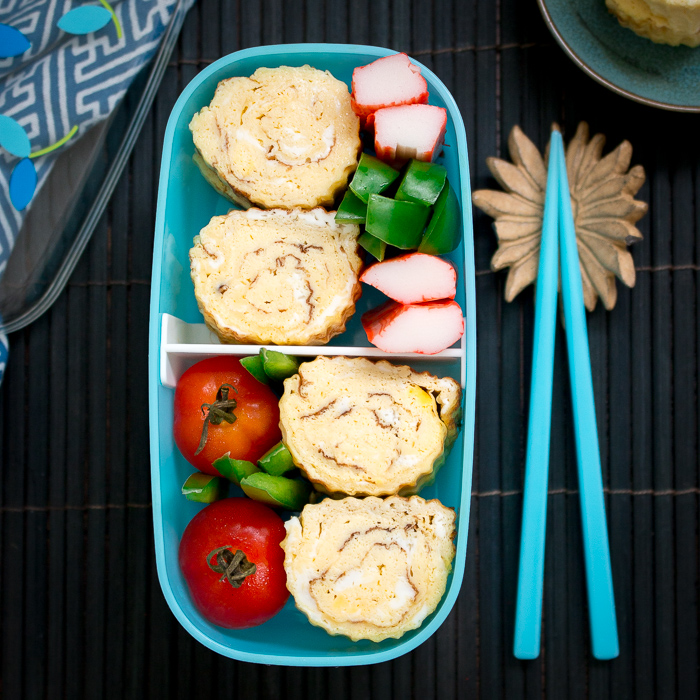
Favorite Japanese Treat
You are just going to love the Japanese Egg Roll recipe because it has all the umami, sweet and savory flavors combined in one delicious bite. These delicate layers of rolled egg are light, fluffy and are the perfect packable lunch bite. Serve it with a side of sesame burdock root salad for a delicious meal.
We made extra so that we could take for school and work lunches for the next couple of days. Cook once - Eat Two times. We are on a roll with meal planning for the busy week ahead.
What is Tamagoyaki?
To say that tamagoyaki is nothing but an ordinary grilled egg would be a complete understatement. It's one of those must try dishes you should try if you ever find yourself in Japan or in a good sushi restaurant. Sometimes, it is served at the end of the meal like a dessert.
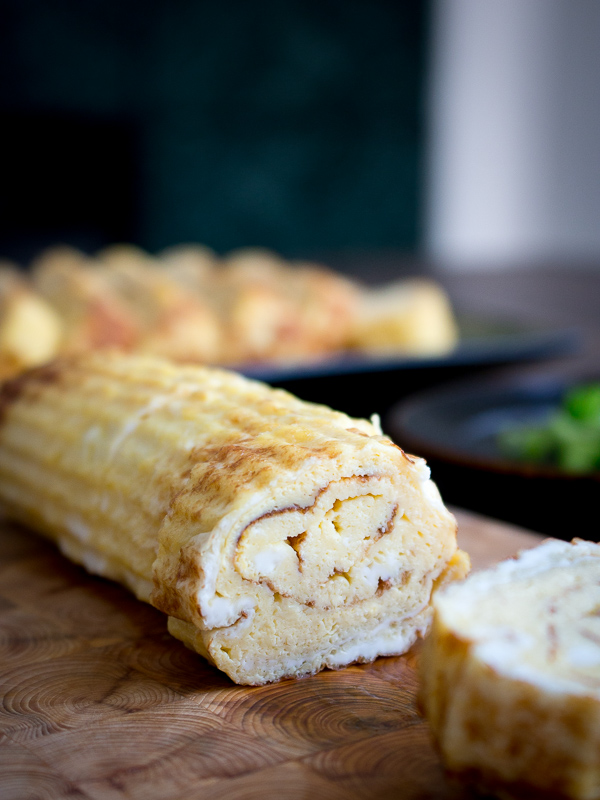
Did you Know this?
Did you know that it is customary for a sushi chef to offer a serving of Japanese egg roll to his customers to show off their chef skills? A beautifully layered Japanese egg roll tamagoyaki is the sign of perfection and thought to be the sign of a seasoned sushi chef.
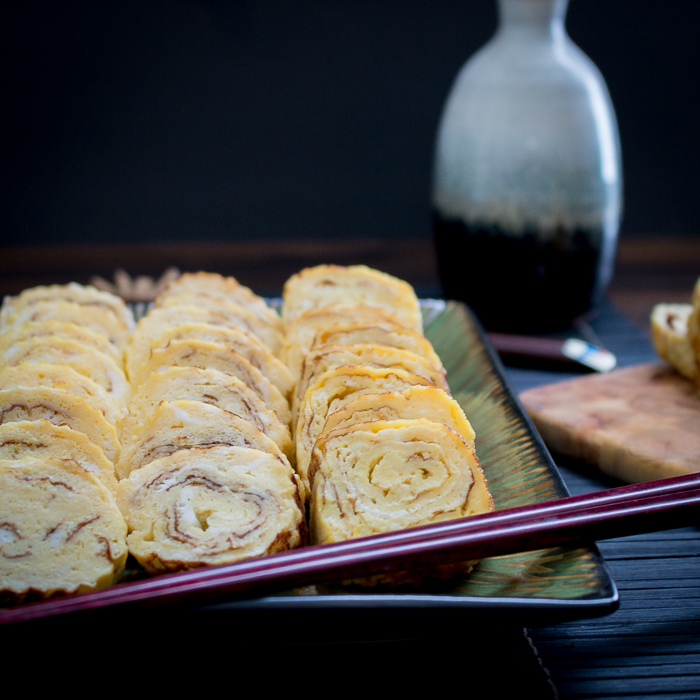
2 Basic Kinds of Tamagoyaki
1) Atsu-yaki-tamago is thick fried egg traditionally made with eggs, sugar and maybe a little soy sauce. This version is heavier in texture, as it is not thinned out with liquid, and it is much easier to roll.
2) Dashimaki tamago is a thinner fried egg made with the addition of dashi broth. Dashi broth is made from a mixture of fish broth and kelp and is a major ingredient in Japanese cooking. The addition of the extra liquid makes the eggs fluffier and lighter and a delightful umami flavor but is much more difficult to roll.
Rectangular Egg Rolling Pan
We have eaten many Japanese Egg Rolls, especially when living in Japan. However, not until we purchased a makiyakinabe (rectangular egg rolling pan) and had the help of four amazing Japanese friends did we unlock the secret to this delicious recipe.
It is not required that you have a Makiyakinabe pan (also known as tamagoyakiki ). You can also make your Japanese Egg Roll in a regular round omelet pan. The main plus of a rectangle egg rolling pan is that it is easy to cut and form unto perfect little slices.
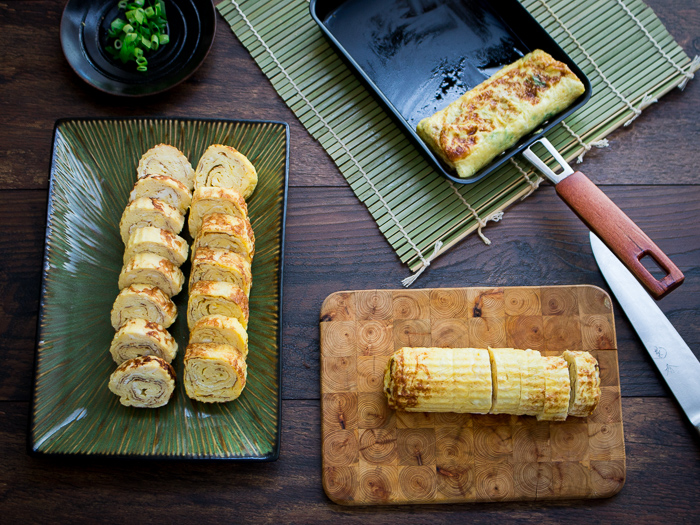
If you do decide to purchase a rectangular egg rolling pan, make sure you get a good one. Heavy Copper and coated with tin with a wooden lid are the best kind. We have one of those cheap Teflon thin rectangular egg pans and the egg sticks and it is difficult to work with.
Japanese Egg Roll Modifications
Our friends know we do not like things too sweet so we came up with a plan together. We added one tablespoon dashi broth, one tablespoon milk or dairy free milk, pinch of sugar, a drizzle of mirin and 3 eggs to the recipe.
This is the perfect ratio for keeping the umami balance in flavors. In addition it keeps the egg light and fluffy and easy to roll, even for beginners.
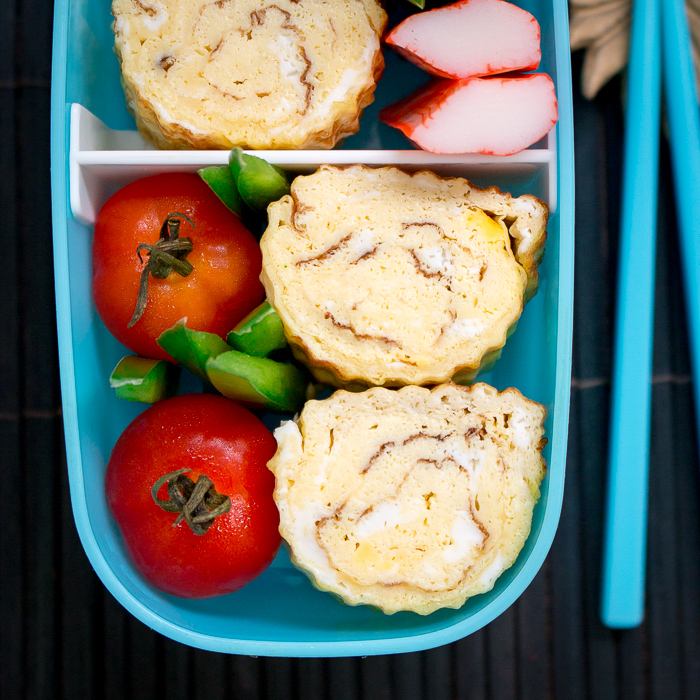
Adjust for Your Personal Taste
- If you like it sweet, you can add up to 3 tablespoons of sugar to the recipe.
- On the other hand, you can add more dashi broth or even soy sauce to make it more savory.
- Feel free to add whatever toppings you like inside the layers. (green onions, crab meat and layers of nori (dried seaweed) are all delicious additions.
- Untraditional as it is, we love the little addition of milk or non-dairy to the egg mixture. It thins it out but not as much dashi broth so the end texture is delicate but still easy to roll.
Recipe Tip: The more liquid you add to the egg mixture, the more difficult they are to roll.
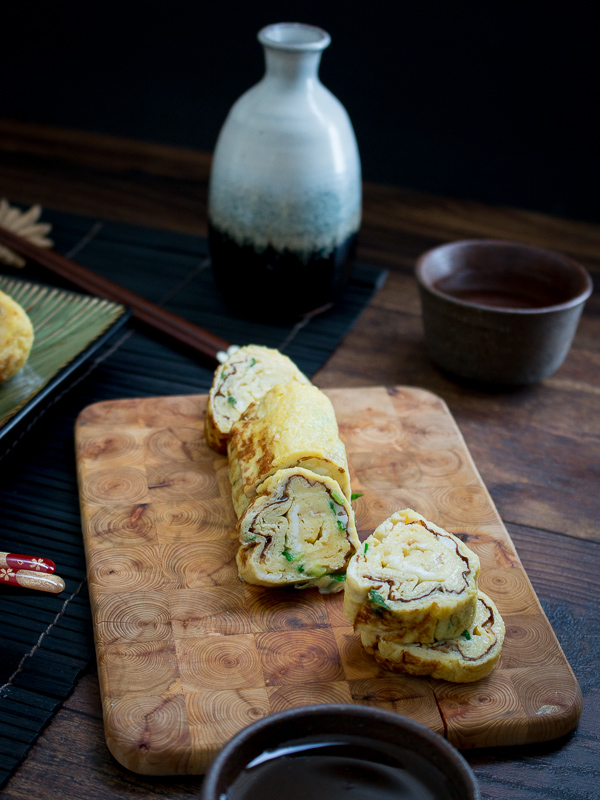
Japanese Cooking Ingredients
We originally used “shiro-dashi”. This is a liquid soup base made from bonito or kombu dashi, white soy sauce, mirin (Japanese sweet cooking rice wine) and sugar to our egg mixture. However, shiro-dashi is more difficult to find outside of Japan.
An easy alternative is just to add warm water to dashi granules to allow to dissolve and then add a little drizzle of mirin. We use the Ajinomoto brand of dashi called Hondashi (Bonito Soup Stock) and mirin. This is not a sponsored post but we always have good results with these products.
Regular vs Aji-Mirin
Regular Mirin is like sake but has more sugar and a lower alcohol count.
However, “aji-mirin” means “Tastes like mirin” but has added sweeteners, etc. Aji-mirin will also work in this recipe as it is already slightly sweet. Go ahead and get a bottle of it and then you can make our sukiyaki beef udon and shrimp tempura udon soup.
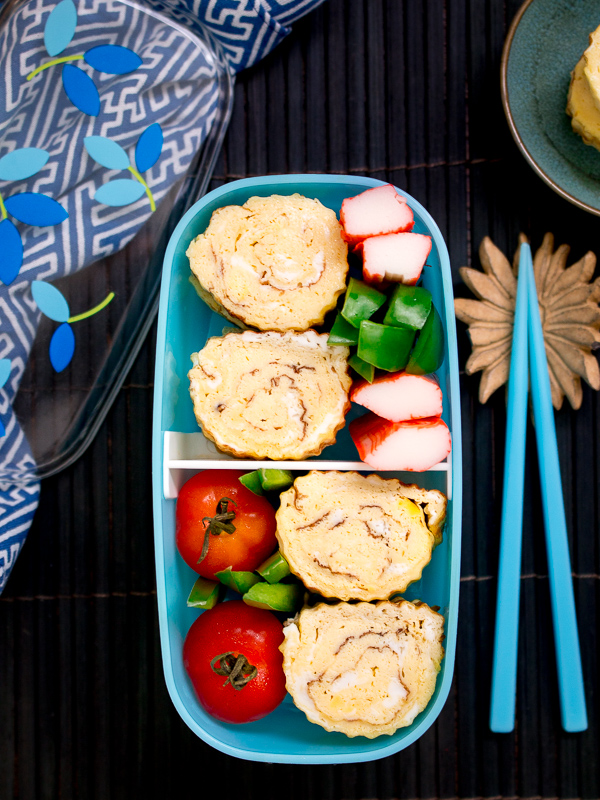
Recipe Tips from Japanese Home Chefs
- Oil your pan well in the beginning and before each layer of added egg.
- Always preheat your pan to a medium heat and pretest with a little of the egg mixture. If the egg mixture sizzle when it hits the pan, you are ready to go. You pan should not be so hot that it is smoking.
- 3 eggs and 3 layers works best.
- You will have to adjust the heat during the cooking process. If using an electric cooktop, you may even need to take the pan off the heat for a bit to regulate the heat.
- Make sure that you get the egg layer up on the sides and underneath the previous egg layer to get the most uniform and beautiful roll.
- Feel free to use a spatula, chop sticks or even the wooden lid to roll. You can see that we have used both to get to the finished product.
- It is okay if your egg is not all the way cooked at the end as it will finish cooking on the bamboo sushi mat.
- After you roll the tamagoyaki, leave it rest for 3 minutes in the bamboo sushi mat.
- Use a sawing motion back and forth to slice the Japanese roll. Be gentle so you keep its round shape.
- Be patient with yourself. The first time you make a Japanese Egg Roll it might not be the prettiest roll. However with each try, your skills will get better and better.
- If you want to make this keto friendly or low carb, substitute stevia for sugar and substitute heavy cream for milk. Skip the mirin.
More Japanese Treats
Shrimp Tempura Udon Noodle Recipe
Pepper Lunch Steak and Rice Sizzle Recipe,
Yakitori Japanese Grilling Recipe
Mung Bean Daifuku Mochi for dessert.
We also have a whole Japanese Recipe Category list to choose from.
Did You Like Our Recipe? Leave a ⭐⭐⭐⭐⭐ rating and/or a review in the comments section below. Your feedback is always appreciated! Follow us for more delicious recipes on Pinterest, Instagram, Twitter and Facebook! Don't forget to sign up for our email list for more free recipes.
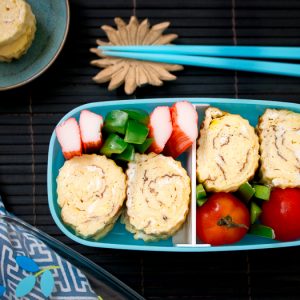
Japanese Egg Roll (Tamagoyaki)
Equipment
- makiyakinabe (rectangular egg rolling pan) or omelet pan
- bamboo sushi mat (nice to have but optional)
Ingredients
- 1 teaspoon Dashi
dried powder - 3 tablespoon Warm water
- 3 Eggs
beaten - 1 tablespoon Milk
or dairy free alternative like almond milk - 1 teaspoon Sugar
or sugar alternative - 1 teaspoon Mirin
or aji-mirin - Oil to prevent sticking to the pan
Instructions
- Dissolve dashi granules in warm water. Stir well. (makes 3 tablespoons of dashi broth so you can make a few tamagoyaki rolls)
- In a bowl, add 1 tablespoon of the liquid dashi broth mixture, eggs, milk or dairy free alternative, sugar and mirin. Beat well until all ingredients are well incorporated.
- Oil a makiyakinabe (rectangular egg rolling pan) or regular omelet pan well. We like to use an oil soaked paper towel to do this so there is not too much oil and make sure you get up on the sides of the pan too. Keep your oil near your pan as you will need to oil your pan between each new egg roll to prevent sticking.
- Heat your pan to a medium heat. Test to see if your pan is ready by dripping a couple of drops of the egg mixture. If the egg mixture sizzles, you are good to go. Do not heat the pan so high that the pan is smoking. The heat should be a medium heat.
- Pour ⅓ of your egg mixture into the pan. Tilt the pan so the egg covers the bottom of the pan. Use either chopsticks, a spatula or whatever you need to grab the edge of the egg omelet and roll carefully and gently vertically from one side of the pan to the end of the pan. Poke any bubbles that occur along the way. Make sure your egg roll end up at the end of the pan. If your pan gets too hot, turn down the heat on your burner or just lift the pan off the burner for a moment. You are going to add a total of 3 layers to your Japanese Egg Roll Tamagoyaki.
- Oil your pan again and add ⅓ of the egg mixture to the pan. This time carefully lift the cooked egg roll in the pan and allow the liquid egg mixture to go underneath. Tilt your pan to each side and lift the edge of the cooked egg roll so that the uncooked egg gets around the sides of the cooked egg roll. Starting with cooked egg roll side, carefully grab and roll and keep your tomagoyaki down to the opposite side of the pan. Remember to poke holes with any bubbles that occur along the way. If the pan is getting too hot, take it off the heat for a moment and adjust your stovetop temperature.
- Okay now for the last layer… Oil your pan again on the bottom and sides. Add the last ⅓ of egg mixture to the pan. Tilt up the cooked egg roll and allow the uncooked egg to get underneath the roll and on the side of the egg roll. Starting from the large cooked egg roll side, roll your tamagoyaki to the opposite side of the pan. Slowly and gently. Poke any bubbles that occur along the way. Allow your finished cooked Japanese egg roll tamagoyaki to sit at the edge of the pan for a moment. Do not worry if your egg is not completely cooked. The egg will continue to cook while resting in the wooden sushi roll.
- Place your Japanese egg roll in a wooden sushi roll and gently but firmly roll and hold to form a perfect circle. Allow your tamagoyaki to rest for about 3-4 minutes and if you want you can even place a plate on top for added pressure.
- Place your tamagoyaki on a cutting board and with a sawing motion, slice your egg roll into 8 slices. Serve and enjoy! いただきます (Itadakimasu) – Let’s Eat!
Video
Notes
- Oil your pan well in the beginning and before each layer of added egg.
- Light flavored oil works best but use what you have on hand and for us that just happened to be olive oil
- Always preheat your pan to a medium heat and pretest with a little of the egg mixture. If the egg mixture sizzle when it hits the pan, you are ready to go. Your pan should not be so hot that it is smoking.
- 3 eggs and 3 layers works best
- You will have to adjust the heat during the cooking process and may even need to take the pan off the heat for a bit if using an electric cooktop. (For this video, we had to shoot on this electric ceramic cooktop that shuts off when you take the pan off the heat. Don’t even get us started but that is not the most convenient thing to happen while cooking tamagoyaki)
- Make sure that you get the egg layer up on the sides and underneath the previous egg layer to get the most uniform and beautiful roll.
- Feel free to us a spatula, chop sticks or even the wooden lid to roll. You can see that we have used both to get to the finished product.
- It is okay if your egg is not all the way cooked at the end as it will finish cooking on the bamboo sushi mat after you have rolled it and leave it set for 3 minutes.
- When you cut your Japanese Egg Roll use a sawing motion back and forth and gentle so you keep its round shape.
- Be patient with yourself. The first time you make a Japanese Egg Roll Tamagoyaki it might not be the prettiest roll but with each try your skills will get better and better.
- If you want to make this keto friendly or low carb, substitute stevia for sugar and substitute heavy cream for milk and skip the mirin.
Nutrition
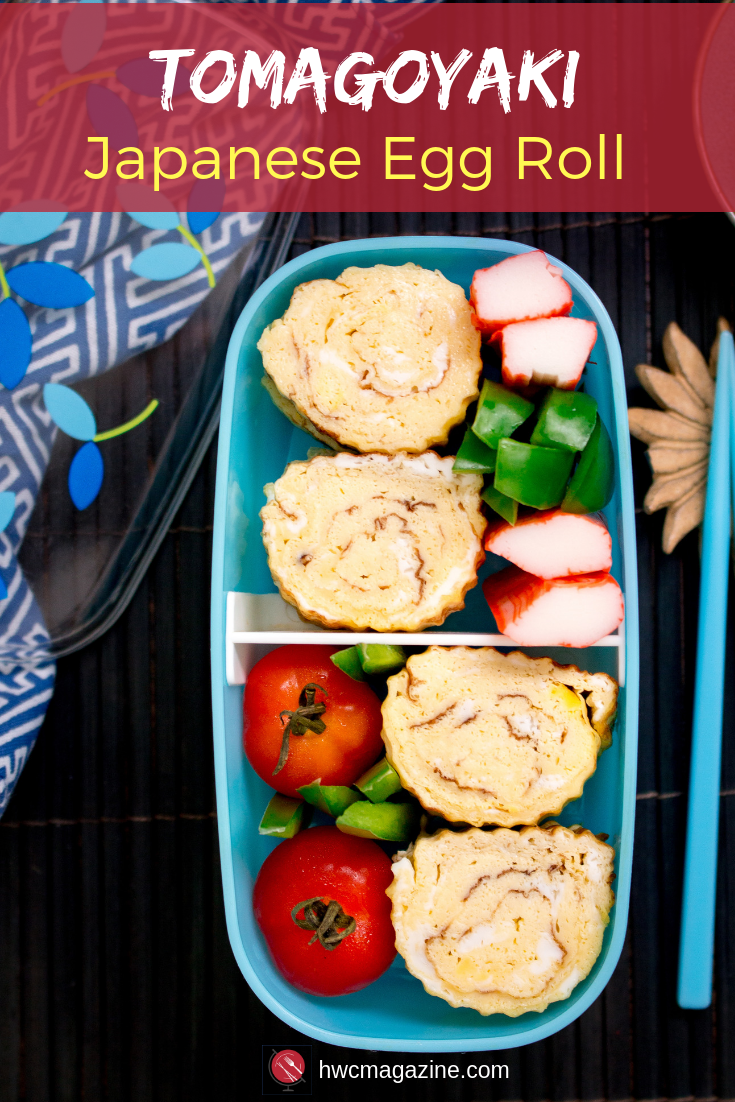


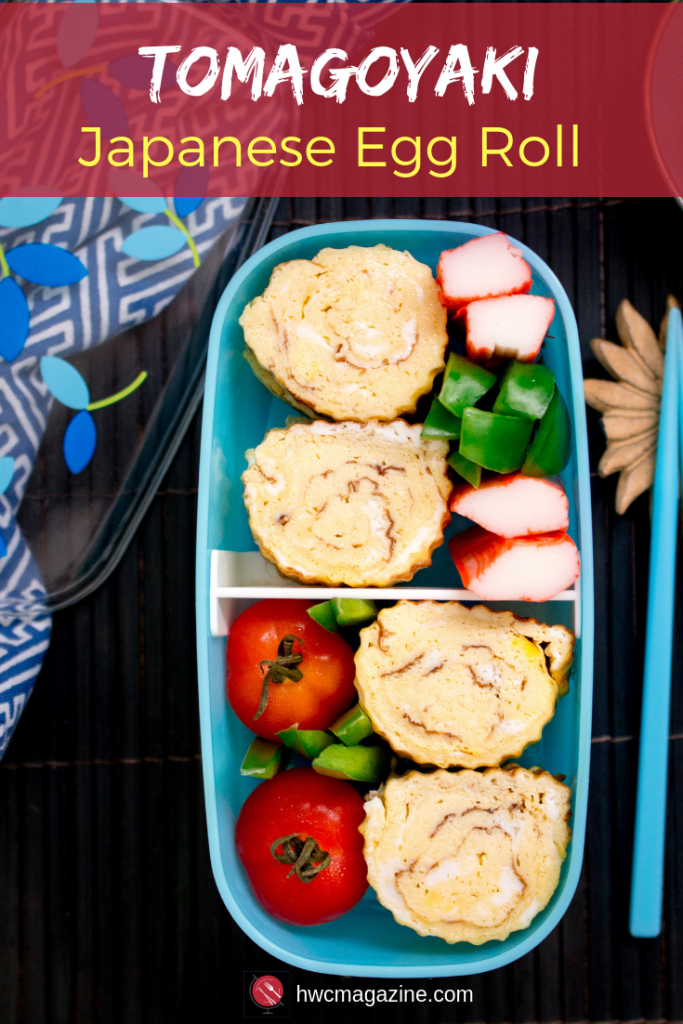
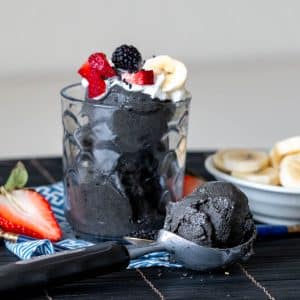
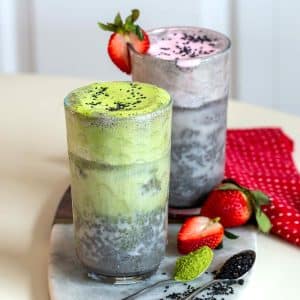
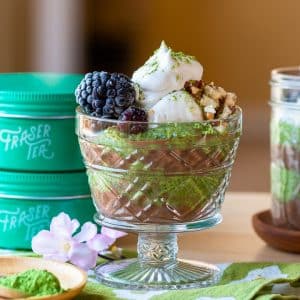
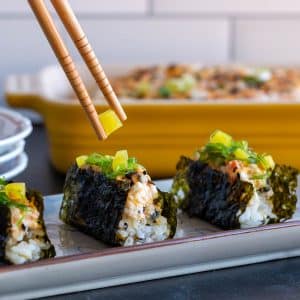

Leave a Reply